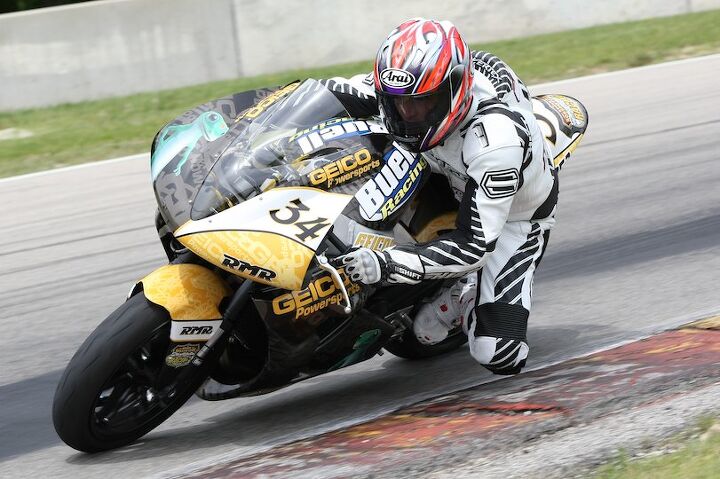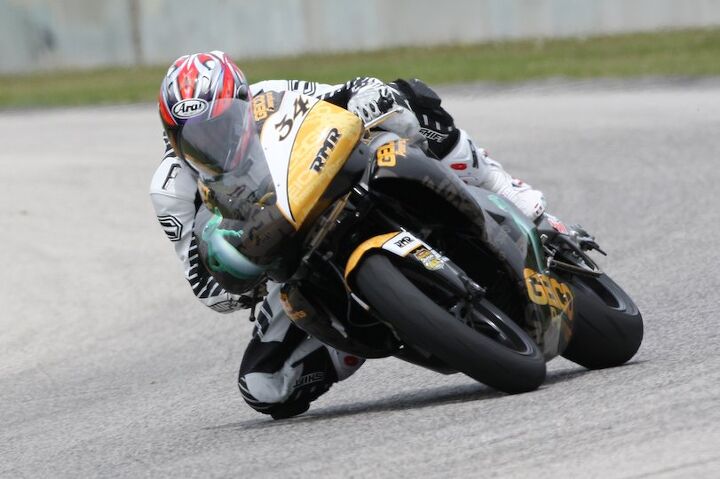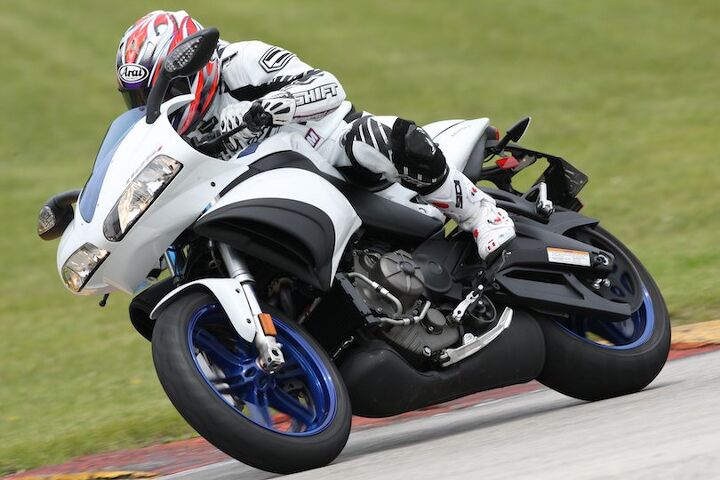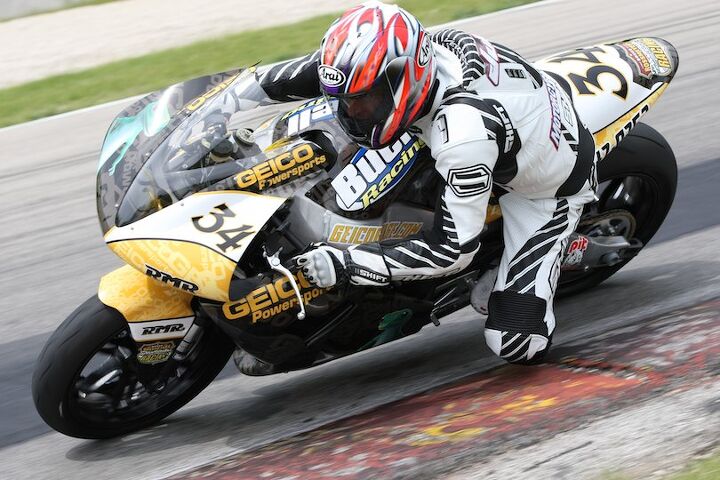Motorsports Racing News & Blog Articles
Church of MO: 2009 Buell 1125R Daytona SportBike Review
It feels weird being back at the Church desk after some time away. John did such a masterful job reviving stories and bikes from the past. This particular Church feature is especially weird on several fronts. First is the fact that it’s a Buell. But it’s not just any Buell, it’s an 1125R. And not just any 1125R – it’s an 1125R race bike that campaigned in the Daytona Sportbike series, otherwise known as the Supersport category when DMG was running “professional” motorcycle racing in America before MotoAmerica took over. This particular bike, seen here piloted by former E-i-C Kevin Duke, was piloted by Michael Barnes. Its sister bike, in the hands of Danny Eslick, would go on to win the championship that year.
Republishing test also brings back some memories because I was there, riding with Kevin, when I was employed at a rival publication. Anyway, here’s Kevin telling his story of what it was like to twist the grip on this unusual race bike.
2009 Buell 1125R Daytona SportBike Review
Buell recently stole headlines with the announcement of a specially modified 1125R joining AMA Pro Racing’s American Superbike class. The 1125RR is a purpose-built racebike (not legal for the street), and its introduction has created waves in the Superbike paddock for the bike’s mid-year arrival and for not meeting the usual homologation requirements.But the armchair crew chiefs aren’t taking into account that the RR racebike isn’t much changed from the modestly powerful 121-horse R streetbike, itself deemed legal for AMA Pro’s Daytona SportBike class racing against four-cylinder 600s.And that’s where current events converge with this story, as we recently had the opportunity to sample a race-prepped Buell 1125R in the same configuration as used by Danny Eslick to win five Daytona SportBike races thus far this season. The main difference between ‘Slick’s Rossmeyer GEICO Powersports RMR bike and the 1125RR is with the engine internals.
Now, some of you may take issue with Daytona Motorsports Group’s rulebook that allows an 1125cc bike to race against 599cc Japanese four-cylinder bikes, and this is indeed a controversial decision. Here’s some comparative specs to ponder.
| Buell 1125R | Yamaha YZF-R6 | |
| MSRP | $12,499 | $9,990 |
| HP (stock) | 121.1 hp at 9700 rpm | 100.0 at 13,400 rpm |
| Torque (stock) | 68.7 ft-lbs at 7800 rpm | 41.0 ft-lbs at 10,900 rpm |
| Wet weight (stock) | 431 lbs | 414 lbs |
| Min. weight (race) | 380 lbs | 360 lbs |
| Complete DSB racer | $25,000 (w/Buell parts) | $30,000 (from Graves Motorsports) |
In stock configuration, the Buell’s engine is 88% larger than a 600, so it’s no surprise to see it produce bigger power numbers, and this is especially evident in its 40% stronger torque peak. To address this disparity, DMG has given the 1125R a 20-lb weight handicap. It’s easy to see why some might quibble with DMG’s rules, but the effect on track has been one of relative parity. Eslick’s wins at some tracks have been counter-weighted by mediocre finishes at other types of track layouts. DMG’s goal was to provide close competition, and in that they have succeeded.
Buell founder and leader, Erik Buell, is an avid racing enthusiast, and in the 1125R he finally has a potent race-worthy machine. Entering the Daytona SportBike class was the first step, followed by the recent announcement of the hot-rodded version called the 1125RR which will be entered in the American Superbike class for the remainder of the season with rider Taylor Knapp. Knapp raced to 12th and 10th places during the recent Superbike races at Mid-Ohio.
Although the 1125R was developed for street riding, it’s also quite capable on the track, as we found out in our Oddball Literbike Shootout. While its 72-degree V-Twin motor won’t run with a Ducati 1098/1198, its robust spread of power makes it easy to maximize acceleration. A stiff aluminum-beam chassis ably handles racetrack-level loads.
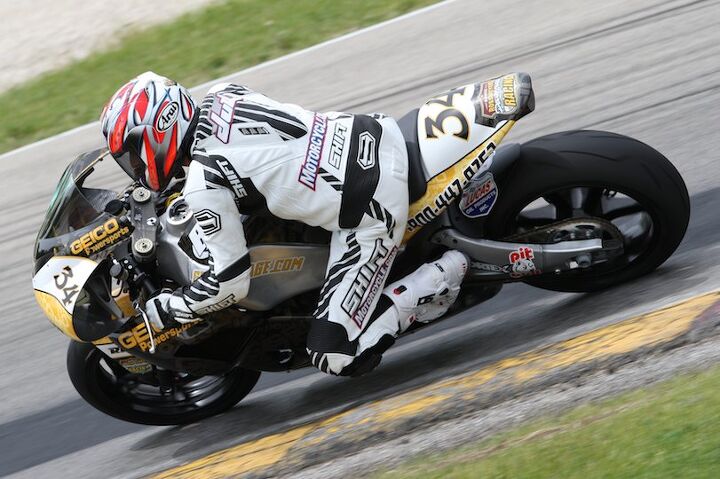
This picture reveals the extended swingarm that comes as part of Buell’s chain-drive conversion kit.
The 1125R’s transformation to Daytona SportBike racer is actually quite mild except for one major item. The streetbike uses a belt to drive the rear wheel, which is a clean and efficient power-transfer system, but this presents problems on the track by complicating gearing changes required to suit each track. Buell has met this challenge by providing a chain-conversion kit swingarm. It’s pricey ($1,779), but it includes quick-change equipment for the wheel, footpegs, brackets and billet swingarm ends with a massive 2.5 inches of adjustment range to juggle the bike’s wheelbase.
On the other end of the complicated scale are minimal changes to the engine. The parts aren’t cheap but they are few: a high-perf stainless-steel exhaust ($1,799) and programmable ECU ($775). The former seems expensive, but the latter is reasonably priced considering a rider can tweak it to adjust air bleed per rpm for dialing in the amount compression braking. These two additions are all it takes to coax out competitive power.
Buell XB12R On Track |
| Buell Motorcycles had its entire 2009 model-year lineup on hand at Road America for journalists to sample. Having never ridden the XB12R on a racetrack, I decided to see how it performed.
Powered by a thoroughly massaged Harley-Davidson Sportster engine, there are a lot of sportbike aficionados who don’t give the XB line much respect. While it’s true that 90 or so horses at the back wheel won’t grab headlines these days, there’s ample torque on tap to tractor its way out of corners without much regard for which of the five gears in the transmission are used. 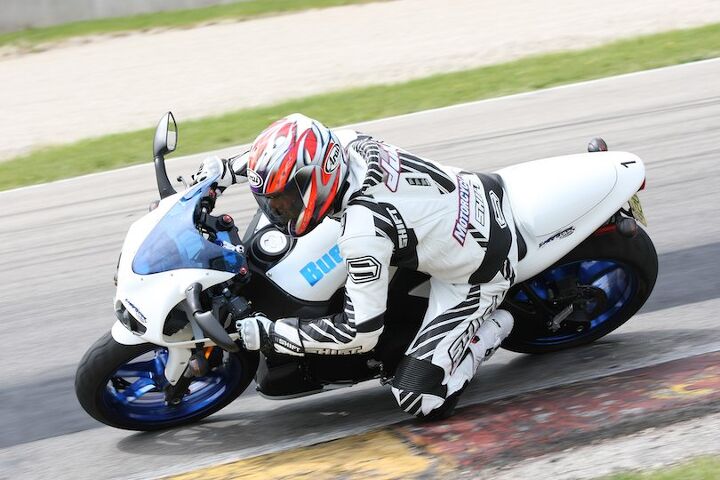 The air-cooled XB12R may run out of steam at a high-speed circuit like Road America, but there’s no denying the bike’s capabilities in the corners. Still, with two-valve cylinder heads and a long-stroke design, the hot-rodded Harley motor feels a little breathless on a high-speed circuit such as Road America. Maximum thrust is gained by keeping the big shaking lump inside a relatively short powerband. A clunky gearbox that doesn’t like clutchless upshifts is an impediment to clipping tenths of a second off your lap times. But where the XB excels beyond expectations is in the corners. Steering is remarkably precise, more than you might imagine, and mid-corner stability is greater than the bike’s steep rake and short wheelbase might indicate. Obedient cornering skills are the bike’s best asset, and there’s plenty of ground clearance to exploit the grip from the Pirelli Diablo Corsa 3 tires. Oddly, while the rear tire got hot, the front tire only got warm at RA. A new addition to the 2009 model-year XBs is an 8-piston front brake caliper that replaces the former 6-piston clamper. It rewards with excellent power that is a significant upgrade over the previously used caliper. As it turns out, my time aboard the XB12R was just a prelude to me joining the AMA Pro Racing schedule at Road America a few days later. I was offered a ride on the XB12R of the James Gang/Hoban Brothers Racing team to contest the AMA Pro SunTrust Moto-GT race in the Moto-GT2 class. Although a little out of my league, it was a Godfather-ish offer I couldn’t refuse. 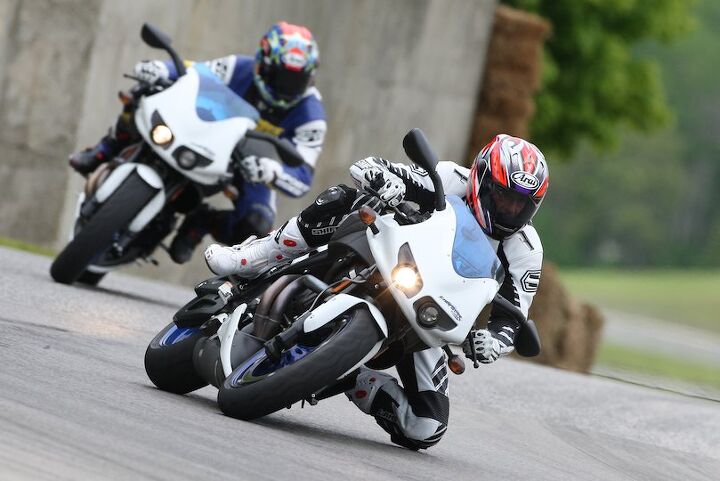 Duke leads his eventual race teammate, Sport Rider’s Troy Siahaan, around Road America in preparation for their Moto-GT race a few days later. Check back in a few weeks to find out how an old and crusty motojournalist fared racing against riders who actually pound out laps for a living. I promise there will be some measure of entertainment value! |
Buell offers three directions to go in terms of suspension. The Showa fork can be fitted with 25mm race-kit internals, said to be quite effective, or can be replaced by Showa’s Big Piston Fork ($1,950). A matching Showa race shock lists for $1,000. However, the 1125R we rode was outfitted with top-shelf Ohlins equipment front and rear, the same as used by Eslick and Richie Morris Racing teammate Michael Barnes.
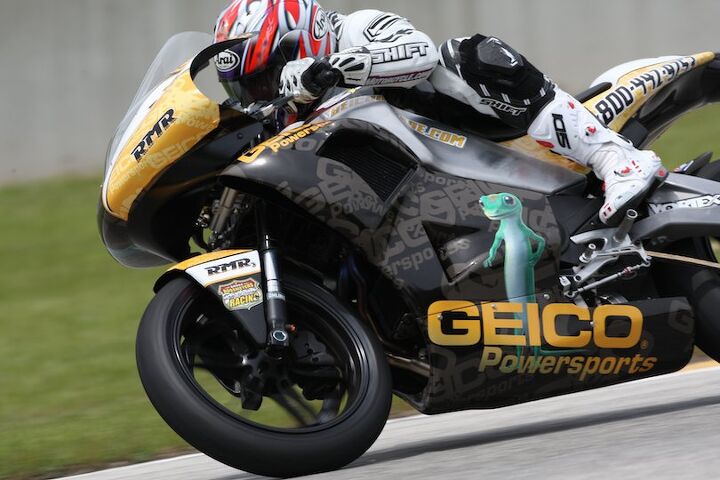
Race bodywork includes a full fairing rather than the stocker’s abbreviated unit. We think it nicely disguises the protuberances of the bike’s side-mounted radiators.
The myriad adjustments available in a quality suspension gives the ability to set up the bike for a variety of track conditions, but there’s more to achieving an optimum configuration. The 1125R has a very steep 21-degree rake which contributes to its agility on the street, but high-speed racing requires elevated levels of stability. So, along with the lengthened wheelbase from the kit swingarm, Buell sells steering head inserts ($233) that extend the rake 0.5 or 1.0 degree; Eslick uses the 0.5-degree set.The 1125R racebike differs from the streetbike visually by the addition of a full fairing for better aerodynamics and to facilitate the necessary inclusion of a catch pan. The fairing also has the side benefit of improving the appearance of the 1125R, smoothing over the engine area for a cleaner look.
Ride It!
There sitting in the Road America pits is a race-prepped Buell 1125R painted up in the Rossmeyer GEICO Powersports RMR livery as ridden by Eslick and Barnes. Former factory Honda crew chief David McGrath is blipping the bike’s throttle to warm the engine prior to my short test session, barking out a raspy and intimidating cacophony. I feel inadequate.
However, the 1125R racer proves to be a surprisingly rideable racebike, as it’s endowed with the same rider-friendly attributes as the stock 1125.
Torque, as you’d suspect, is plentiful, catapulting the 1125R quickly through first gear despite tall racetrack gearing. Very quickly it demands an upshift, and this is accomplished posthaste via quick-shifter electronics through a race-pattern (1 up, 5 down) gearbox. The $279 shifter kit is worth every penny on the racetrack.
The Buell/RMR bike we sampled at Road America had the plus-1.0-degree steering-head insert, which should slow the 1125’s steering responses, as should the longer wheelbase from the kit swingarm. But it instead responds with alacrity. Credit goes to a lighter weight (though more than the 380-lb class minimum) than the streetbike and the addition of feathery magnesium wheels that knock off 1.8 lbs from the front wheel ($954) and 3.0 lbs from the rear ($1,011) compared to the stock cast-aluminum wheels.
The RMR crew has done significant juggling of ride heights during development to alter steering geometry for the optimum setup. Like all racebikes, the RMR 1125R is set up stiffer than stock, as the springs inside the Ohlins dampers help keep chassis pitch to a minimum. The result is corner entries that can be taken very quickly and are accompanied by confidence-inspiring stability mid-corner, aided by a $495 Ohlins steering damper.
Even though the engine is totally stock except for the kit ECU and exhaust, the linear and broad torque curve pulls like a demon out of the corners, even if a gear too high. The way in which the 1125cc engine produces power is exemplary, providing smooth response from closed throttle positions. Strong though the Helicon motor is, with 140-plus horsepower at the wheel, there’s no way it can run with something like the Ducati 1198. However, to a mid-pack-placed racer, this grunty motor is a walloping advantage over a peaky four-cylinder 600. An excessive amount of vibration felt on the right-side footpeg is a slight distraction.
There are four hard braking zones at Road America, and these really put Buell’s ZTL braking system to test. The stock 375mm perimeter-mounted rotor is replaced with a 1mm thicker disc (to 6mm) to better handle the heat generated on a racetrack. Its cost is just $170, but you’ll need $241 of hardware to mount it. The massive 8-piston caliper is beefed up with track-specific brake pads ($368), and a race-duty Nissin master cylinder ($715) supplies excellent feel at the lever.Corner entries are aided by the Helicon engine’s built-in back-torque-limiting system based on the amount of vacuum generated though the motor. This functions like a mechanical slipper clutch, although it isn’t quite as effective. That said, Eslick doesn’t race with a slipper clutch, as his back-it-in style seems to suit the bike. Stiffer clutch springs are the only alteration from stock.
Even just a few laps on the RMR Buell 1125R were enough to learn that this Buell-supported effort is a highly capable yet easy to ride race machine. It easily handled my timid efforts to go fast, and it continued to feel better the harder I pushed it.
Just as impressive, and perhaps even more so, is Buell’s expanded commitment to racing. The Little Company That Could has done the necessary homework to enable any racer to bolt on about $13,000 of parts to create a highly competitive Daytona SportBike, and you can one-stop-shop them at your local Buell dealer via the company’s race department. Buell also offers a nice pot of contingency money for its racers.
And all signs point to further race support from Buell in the future. An astute racer such as Erik Buell didn’t hire a super-wrench like David McGrath just because he’s a nice guy. We suspect McGrath will spearhead a more elaborate racing program, and the newly released 1125RR superbike is just the tip of the iceberg. Buell has opened up a dedicated race shop down the street from the company’s headquarters for McGrath to work his tuning magic, and it’s reasonable to expect the operation will expand.
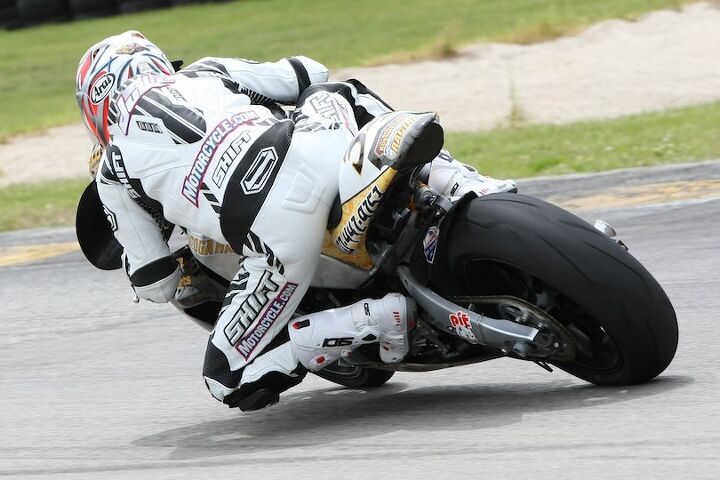
The addition of several Buell-supplied race components transforms the 1125R into a winning combination.
We interviewed Mr. Buell back in 2007 and asked him about his racing intentions for the 1125R and his future projects. “It all has to be fundamentally spun into the business package,” he said shortly after the launch of the 1125R. “Maybe one of these days that will happen. When we were talking to Jeremy (McWilliams) and some of the other test riders, I sat down with him and looked him in the eyes and said, ‘Okay, Jeremy, if some magic happens and we go World Superbike, what do we need?’ And he said, ‘Nothing but power, Erik.’ I said, ‘Okay, that’s what I wanted to hear.’”Of greater importance to street riders, Buell’s bolstered race efforts may also be accompanied by a larger, more powerful and more capable production motorcycle. Think about it: Buell is going Superbike racing with an 1125cc engine when V-Twins are allowed 1200cc. It would seem foolish for Buell not to produce a 1200RR, providing a stouter base to take on the Superbike heavyweights.
Make a return visit here about this time next year to see if our prediction for Buell’s 2011 model announcements include a 1200cc superbike contender.
Become a Motorcycle.com insider. Get the latest motorcycle news first by subscribing to our newsletter here.
The post Church of MO: 2009 Buell 1125R Daytona SportBike Review appeared first on Motorcycle.com.
Copyright
© Motorcycle.com


